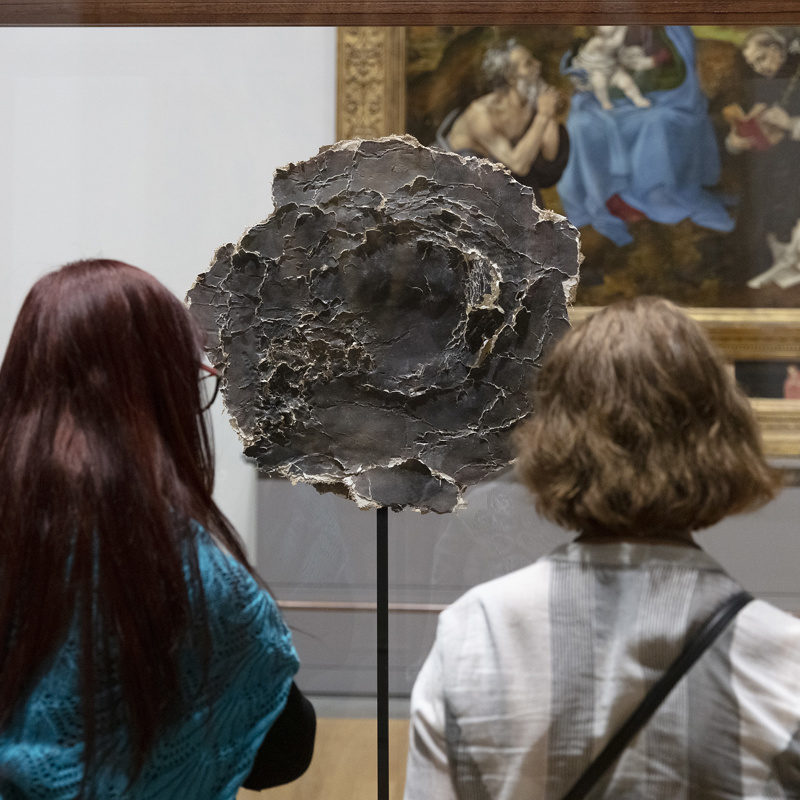
How we select our Artist in Residence
The Gallery has a long history of working with living artists. Residencies are an important part of this. Going back to 1980, and involving artists such as Paula Rego and Michael Landy, residencies offer artists the opportunity to develop their practice, and help us to see the collection in a new light.
The Artist in Residence programme, established in 2019, invites a mid-career artist to work within the artist’s studio at the Gallery for up to one year, using the resources offered by the collection and museum to develop their practice. The artist has the opportunity to present their work in the context of the collection, to make a book about their project, and to have one work produced in connection to the residency acquired by the Contemporary Art Society for a public collection based elsewhere in the UK.
How long does it take to find the candidates?
The residency typically lasts for 12 months, which is quite a commitment for an artist, so we try to give them as much notice as possible. The process to find the artist starts at least six months before the residency is due to begin. We convene a jury to help us nominate and make a decision and invite the selected artist on their advice.
Why do we use a jury to select the Artist in Residence?
The jury system puts diversity of opinion and rigorous collective discussion at the core of the decision-making process. By drawing upon the expertise of colleagues both within and outside the National Gallery, we expand the pool of potential artists considered for the residency and ensure that the final selection is made through a strong consensus of different voices and perspectives.
Who is involved in the selection?
Daniel Herrmann our Curator for Modern and Contemporary Projects at the Gallery chairs a group of six people that comprise the jury. This is made up of a range of people who bring different arts experience to the process. Alongside Daniel the jury includes:
- A curator from the Artist in Residence partner museum. This year, Sarah Hodgkinson, Senior Curator at Touchstones was on the jury alongside Liz Mytton, Director of Theatre in Flow, Rochdale.
- The Director of the Contemporary Art Society, Caroline Douglas.
- A colleague working within an UK arts organisations that has experience with residency programmes. This year we approached Rosie Cooper, Director of Wysing Arts Centre, Cambridge.
- The director of a non-collecting arts institution in the UK. Sorcha Carey, Director of Collective, Edinburgh took part in the jury this year.
- And finally an artist who this year was Elizabeth Price, Artist and Professor at the School of Art, Kingston University to share her valuable experience of how artists may work with arts organisations in different ways.
We ask each juror to put two artists forward for consideration.
Can any artist be included in the short list?
We ask the jury to nominate artists that are mid-career: they should already have an established practice, but the residency should be an opportunity for them to develop their work further or think about it in a different way. There are usually no constraints in terms of medium or the nature of the artist’s practice and the artists do not need to be based in the UK.
Once the jury members have each submitted the names of the artists they want to put forward, we circulate details of all 12 nominees to the group in advance of a ‘jury day’.
On the day itself, the six jurors meet at the Gallery. They introduce their proposed artists, discuss all the nominees, and finally select an Artist in Residence. We then contact the selected artist to invite them to the residency. This year the jury advised us to approach London-based artist Katrina Palmer, who uses objects, sound, writing and drawing to explore the possibilities of sculpture through text and language.
What factors come into play when deciding who to chose?
The jury discussion focuses on the strength of the artists’ practices and their suitability for the residency. The jurors are interested in artists who would use the residency to make a significant shift or development in their work; who could establish a meaningful relationship with the collection; and who have a resilient practice that could thrive in the context of a national institution.
The jurors also consider the different ways in which the residency might benefit an artist. This could be in terms of profile, the opportunities currently available to them, or their presence within UK public collections.
The jury also consider the context of the partner museum’s collection and audience. In the case of our 2024 Artist in Residence, Katrina Palmer, the jury found the way that she has previously embedded herself within sites to develop her projects to be an appealing prospect for both the National Gallery and Touchstones Rochdale.
When does Katrina officially take up the residency and how will she be welcomed to the Gallery?
Katrina Palmer’s residency will begin in December 2023. Upon her arrival, Katrina will move into the on-site studio and will be introduced to colleagues in different Departments in the Gallery, from curators and framing experts to art handlers and scientists, to find out what they do. Getting to know the Gallery behind the scenes is something most artists enjoy and find useful as they begin to research ideas for their show.
Find out more about our Contemporary Residencies


